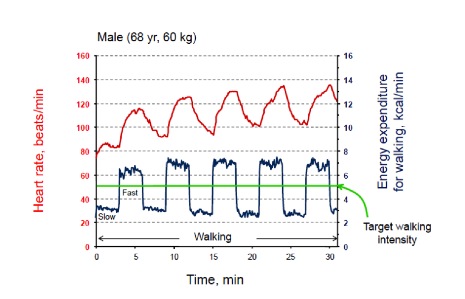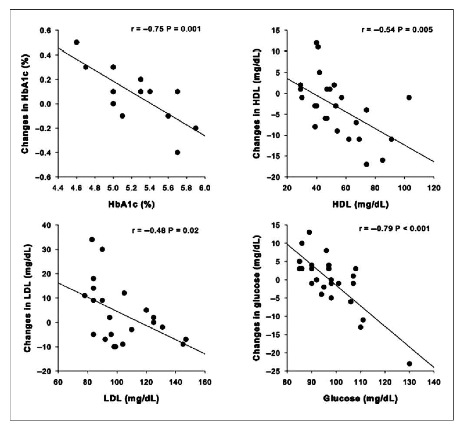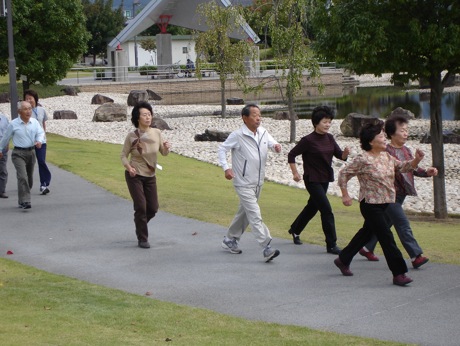Interval Walking Training
In several recent posts I have focused on physical activity and health and also the link between obesity and inactivity. Not a lot of good news if you look at the population statistics, but good news if you think about just how protective exercise and physical activity are both in terms of obesity and also general health. So, what to do about it?
Perhaps the easiest, cheapest and most convenient form of exercise for most people, especially middle aged (40-65) and older (>65) people is simply walking. One of the best and most effective ways to get the most out of your walking is to do something called Interval Walking Training (IWT). This program was developed in the Japan by my close friend and colleague Hiroshi Nose, and his research team to help thousands of people get into better shape.
The idea is to use the same principles that elite endurance athletes and Olympians do when you go for a walk. To get in the best shape possible the elites do work outs that include multiple 3-5 minute efforts that are nearly all out followed by 2-3 minutes of recovery several times or more per week. Both scientific studies and practical experience suggests that this is a key to getting in the best possible shape. It also gives you incredible “bang for the buck” in terms of time, and what works for the elite athletes can work for us all.
The IWT program consists of 5 or more sets of 3 minutes of low-intensity walking followed by fast walking for 3 minutes four or five times per week. Low intensity walking should be a bit faster than a stroll (40% effort) and higher intensity walking should be at greater than 70% of maximum effort. Hiroshi’s team has used this approach in a number of their studies and they use heart rate monitors and tracking devices called accelerometers to set and measure exercise intensity.
The figure below is one that shows a typical heart rate response and calorie consumption pattern with this type of training in one of the subjects in Japan. It was sent to me by Dr. Shizue Masuki and the data was collected by Dr. Ken Miyagawa, they are both key members of the Nose team. Hiroshi had the following comments about the data:
“As shown in the figure, HR increases to ~130 beats/min during fast walking, but decreases during slow walking, This slow walking or recovery period is important because it motivates a subject to walk at high intensity again. Moreover, because the interval walking training was performed in a hot environment (atmospheric temperature=32 C, RH=60%), HR level increases with increasing body temperature, which makes it difficult to estimate walking intensity from HR accurately. Therefore, it is important to monitor walking intensity with a tri-axial accelerometer.”
Does this work? To quote one of the early papers on IWT:
“In the IWT group, isometric knee extension increased by 13%, isometric knee flexion by 17%, peak aerobic capacity for cycling by 8%, and peak aerobic capacity for walking by 9%, all of which were significantly greater than the increases observed in the moderate-intensity continuous walking training group. Moreover, the reduction in resting systolic blood pressure was higher for the high-intensity interval walking training group.”
Below is a figure from a collaborative study that we did with the team from Japan. It shows what happens to selected inactivity associated risk factors when 26 previously sedentary people (average age 54) followed the program about four days per week for three months. The people with the worst initial values for HbA1c (a diabetes related marker), HDL cholesterol, LDL cholesterol and glucose showed the biggest improvements with IWT. We also found big increases in exercise capacity and reductions in blood pressure. So, it worked!
In an article in the New York Times on what the best form of exercise Professor Nose put what IWT can do for people in laymen’s terms.
“Physical fitness — maximal aerobic power and thigh muscle strength — increased by about 20 percent which is sure to make you feel about 10 years younger than before training…….symptoms of lifestyle-related diseases (hypertension, hyperglycemia and obesity) decreased by about 20 percent, and depression scores dropped by half.”
I am closing with a shot of a beautiful park in Matsumoto, Japan where the Nose team is located and where many of the subjects he studies do their walking.
This entry was posted on Monday, August 27th, 2012 at 6:15 am and is filed under Physiology, Research and Health. You can follow any responses to this entry through the RSS 2.0 feed. You can leave a response, or trackback from your own site.





August 28th, 2012 at 9:19 pm
Hello Dr. Joyner
Well done on your mission and blogs. I found today’s blog regarding IWT particularly interesting and relevant. I couldn’t agree with you more on the effectiveness of walking…for all ages. In fact, I recently published a children’s book chronicling the true story of my own 9 year old daughter’s fitness transformation which was based on a daily 60 minute ‘brisk walk’ with dad. The results she achieved were very compelling and validate the fitness benefits of walking. Please check out our story at http://www.abbiegetsfit.com. Thank you and keep up the good fight!
Yours in health,
Doug Werner
dwerner@healthtrax.net
Cell: 860-682-3125
August 29th, 2012 at 8:39 am
I use interval training with my fitness clients quite often. I find it to be the most effective form of training for weight loss, as well as fending off boredom.
January 6th, 2013 at 11:03 pm
Tracking Your Fitness: Aerobic Capacity | WellEvolvEdU says:[…] lbs. exercising for 20 minutes. The speed levels for walking, and the workload for stationary biking are considered to be relatively mild to moderate levels for […]
January 18th, 2013 at 3:00 pm
Boosting Your Metabolism: Nutritional Support and Proper Exercise | WellEvolvEdU says:[…] Interval Walking Training Study […]
January 20th, 2013 at 6:58 pm
Start-Up Lean Fitness Metabolic Boost | WellEvolvEdU says:[…] Interval Walking Training Study […]
March 3rd, 2015 at 9:19 am
want to feel 10 years younger? | walktalk says:[…] in Japan, enrolled thousands of older Japanese citizens in a five month long program of brisk, interval style walking (three minutes of fast walking followed by three minutes of slower walking, repeated 10 […]
April 11th, 2015 at 10:16 am
Easy Fitness Method? - Body & Soul MentoringBody & Soul Mentoring says:[…] New York Times Article Dr. Joyner’s blog post […]